The Bank Job: A death in the family sends a couple on a journey to crack the case of the unexplained keys
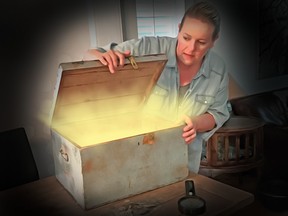
Article content
My mother-in-law passed away recently. It was sudden and unexpected. We had taken her shopping for her monthly grocery haul two days prior, and I had been feeling guilty about not having the chance to call her before jetting off to a four-day assignment in Mexico in early January—I had already written her a postcard when my husband, Mike, called.
Shirley lived alone, by choice. Her small duplex was full of trinkets—a neatly organized clutter of photos and mementos of everything she valued in her life. When we returned to the now-empty house, Mylar balloons saved from her 83rd birthday party less than a month before slouched against a wall. (When the balloons were completely deflated, she would flatten them and store them in one of her dozens of albums.) There were still slices of cake in her freezer.
I sat at the dining room table and flipped through her recipe box of address cards, calling the old friends and relatives she talked about the most, to give them the news.
It’s an exhausting and invasive thing, one brimming with anxiety and nostalgia, to sort through someone else’s lifetime, to clear out her fridge and bathroom and underwear drawer, to decide what should go in the garbage, what can be given away, what would wind up stored in boxes in our own basement for someone else to find. There was only Mike and me to plow through it all.


On the surface, everything was familiar, most of it having been in the same place for the 30 years I’d known Shirley. A lot of it came from me. In her absence, however, it all seemed otherworldly. We began pulling back wool blankets that had been nailed over storage shelves and explored long unopened boxes in the recesses of the basement. Shirley had saved everything: every
Christmas and birthday card of her adult life, sets of the Encyclopedia Brittanica, stacks of National Geographic, decrepit old dog toys (the dog died 20 years ago). This is perhaps not unusual for a child of the Depression, who recalled her mother spreading tinned peanut butter on slices of homemade bread to hand out to hungry men coming off trains to look for work in rural Saskatchewan. There were things hidden under other things—a side table in the spare bedroom revealed itself to be a tablecloth-covered filing cabinet. We unearthed report cards and bank statements last seen in Mike’s grandfather’s garage in the 1920s, old newspapers, high-school yearbooks and love poems, the Planet of the Apes and Evel Knievel action figures of Mike’s childhood, evidence of a previously unknown marriage and an original Pong game. And once in a while, we came across long, flat keys.
There were plenty of old house, bike and car keys, but these were different from the rest. They had numbers stamped on them. We knew peripherally that Mike’s dad had had safety deposit boxes, but had no idea where they were or what they contained. There was talk over the years that some of them had been inherited from his uncle, who passed away in the 1990s—but we hadn’t asked enough questions. They weren’t talked about, and questions often came across as suspicious. Mike’s dad was the beneficiary of the estate, but he has been in long-term care for over a decade. He hadn’t retained many details regarding the boxes nor, we suspect, ever shared specifics with Shirley, who after decades of rarely being privy to the financial aspects of their marriage, eventually wound up with Power of Attorney over their affairs. In short, a complex web of trip-wires lay between us and sorting out the estate.
Over weeks and months of cleaning and clearing, we came across more keys. An old jewelry box from the Bay, wrapped in multiple plastic bags secured by elastic bands, contained four. There were more in a pale-blue coin purse. We found keys in baby food jars and one in a beat-up lunchbox in the basement, under a jumble of pens, doorknobs and key chains. Some were in small manila envelopes, some of which had numbers written on them. Shirley had neatly scripted “Bank of Montreal” on one. We amassed 17 keys—some were clearly duplicates—and the numbers of seven boxes, with no locations save for the vague Bank of Montreal lead.
Here’s the irony about safety deposit boxes: they were so safe, people forgot about them. It wasn’t as if they were filled with things people needed to access on a regular basis. Banks issued a nondescript numbered key or maybe two, signed some papers, charged a fee and that was that—years would go by without anyone checking on them. People moved, got sick and died. Keys went missing. One envelope warned, in 1960s font, that the two keys it contained were the only ones in existence—”use one and retain the duplicate in this envelope in a SAFE PLACE.” (Like a safety deposit box?)
Here’s something else to know about safety deposit boxes: the numbers on the keys don’t match the box they belong to. Despite the fact that Shirley filed away every piece of paper—every bill, statement and letter—none revealed any clues as to where these boxes might be. Fees didn’t show up on bank statements, or were hidden. Of all the paperwork that was saved just in case—old car insurance and decades-old property assessments—there were no safety-deposit rental agreements. We wondered if the boxes had just been abandoned.
But we had the keys. Our first stop was Shirley’s neighbourhood bank, the one we had both been driving her to for years, hovering alongside her transactions to ensure questions and instructions weren’t misinterpreted due to her poor hearing. The tellers knew us, and helpfully and sympathetically confirmed that one box was indeed at that bank, just not at that location. They sent us to another branch, confident we had the required paperwork to access the box.
It turns out that gaining access to the safety deposit boxes of deceased relatives has little to do with the simple rental agreement and everything to do with the individual you happen to speak with at that branch. Despite having the death certificate, will and a copy of the power of attorney (PoA), we were refused access by the assistant manager, who requested a letter from a lawyer and additional paperwork, including medical documents and the original PoA (which really shouldn’t apply here anyway, as the box was in Shirley’s name). The original documents were most likely in the safety deposit box, we explained. She did not relent. Eventually, after a few trips and the requested letter from the lawyer, she allowed a brief, supervised peek—the original PoA was indeed in there, and she allowed Mike to take it, but nothing else. Now, months later, we’re still waiting for the court to grant probate so we can reclaim the rest of the box, which ironically contains only those documents that might come in handy in the event of her death. That is to say, the box contains nothing of value to anyone who isn’t attempting to sort through her very small estate.
— — — — —
Spring break this year involved going to banks and asking if they happened to have any safety deposit boxes in the family name. TD Canada Trust had a database; workers could check on the computer at one branch and see if there were any boxes at any of their locations. Other banks weren’t as easy; we had to go and ask one by one, and most often the question was perplexing and not easily answered. We visited the Bank of Montreal on 17th Avenue, the one closest to where Mike’s uncle lived in the 1980s and ’90s. We were hopeful, given our Bank of Montreal lead, but there was no record of any boxes there, nor at any other branches. Another bank told us that it didn’t appear to have any, but that after a certain length of time, safety deposit boxes were drilled out and sent to a main warehouse, their contents sold at auction.
One day at Shirley’s, I came across a bank statement from the ’90s with Mike’s uncle’s (his dad’s brother’s) name on it, listing the annual fee for five safety deposit boxes. A clue! An actual location! The last number of the year was cut off, but assuming that these boxes had been kept for 25 years, and that the $110 annual fee had never increased, to date it would have cost $13,750 to store whatever these five boxes contained.

We went to the bank—it was a new branch; the boxes must have been transferred—with our random keys and scribbled numbers. A teller confirmed that there were boxes onsite that matched the surname and five of the keys. But there was a process. We were told to come back after the long weekend, at which point we sat in a small office for almost two hours while the bank pondered our credentials. As lunchtime neared, they said we could get into the boxes. Follow us to the back, they said. We got up, giddy to finally solve the mystery, dying to know what was inside. Halfway back, they stopped. Never mind, they said, another bank authority says this copy of the PoA wasn’t good enough, we needed the original.
We had given that treasured document to our lawyer. I emailed him from my phone. It was at another bank, he replied from a plane that was about to take off. We hustled over to the bank, only to discover that the branch manager was on leave and the person we had been dealing with was on vacation in Australia, but someone located the papers and we returned in triumph, flush with the thrill of the hunt. They finally let us in.
Mike extracted the first long metal box from its spot amid hundreds of identical boxes in the walk-in safe. The box was about six feet off the ground, and was almost too heavy to carry. We brought it into the small room reserved for such occasions—the front wall was open at the top and bottom like a bathroom stall, allowing some privacy, but not too much.
The box was filled to the brim with stacks of coin sets, many of them still in their stamped shipping boxes, addressed to his uncle. There were Olympic commemorative coins, rolled coins, Crown Royal bags full of coins. The second box was heavier than the first. Old cardboard boxes that once held chocolates and Christmas ornaments were filled with snug rows of giant pennies, silver dollars and 50-cent pieces. There were stacks of envelopes full of crisp one and two dollar bills—dozens of them, each containing a stack a finger thick. Some mint-condition coins were protected by plastic-windowed square cardboard covers; others were worn, and rattled around the bottom of the box. Some looked exquisitely rare: a 25-cent bill from 1923, enormous 1965 Churchill commemorative coins, 20-cent coins and Indian Head pennies. There were rolls and bags of tombac nickels—during the Second World War, nickel was in such demand that the mint temporarily abandoned its use in coins, making yellow five-cent pieces out of a type of brass called tombac.
The remaining boxes revealed similar treasures: coin sets from the 1970s and ’80s, each containing one pristine quarter, dime, nickel and penny from the year they were minted, suspended in clear plastic sleeves. In the last box, we discovered a few slim bars of silver and one tiny gold bar, about the size of a two-stud Lego brick, buried beneath envelopes and folders of untouched 32-cent Canadian stamps. What was it about collecting coins and stamps?
Having done a thorough inventory, we were told for reasons too dull and ridiculous to recount here that we couldn’t put the boxes back; we’d have to either do the paperwork and rent new boxes in our own names, or take it all with us. We ran home for green bins and milk crates and lugged hundreds of pounds of it home. For a few weeks, our house resembled Scrooge McDuck’s.

Being in possession of literal piles of money you can’t really spend is an odd dilemma. It’s exhilarating to discover thick wads of immaculate bills; one might imagine that crisp, new ones and twos and vintage fives and 10s might be worth a little extra something almost 30 years after being printed. They’re not. The silver lining is that this is the last year these Canadian notes are legal tender at the bank, so we were able to deposit them at face value—kind of anticlimactic after the effort of someone buying them and paying for their safekeeping for decades. I wanted to put them in my wallet, along with the silver dollars and 50-cent pieces (more than 2,000 of them), just to make things interesting at the grocery store.
The same applied to the coins. Those in sets, we discovered, would be worth only marginally more than the sum of their parts—not really worth the effort of listing on eBay. We sorted and separated about 15 pounds of silver coin, and fell down the rabbit hole of collector websites, with their exhausting charts of coins, years, and minutiae about which specific nickel might be worth hundreds or thousands of dollars if you can find a little dot at the bottom, or the date is ever so slightly larger than most, or if the beaver is in high relief or the Queen’s gown is missing a fold. We became obsessed, searching through mountains of nickels with flashlights and magnifying glasses until it felt as if our eyeballs might fall out, never discovering that elusive but oh-so-similar rare treasure. Annoyingly, even impressive pieces like the dodecagonal 1943 tombac nickels, and those made in subsequent years from chromium-plated steel, were only valued at around 20 cents. The smooth, heavy Churchill commemorative coins, twice the size of silver dollars, go for between $2 and $5. Of course, even the more valuable coins only pay off if a buyer can be found, and eBay widens the pool available to collectors. As it turns out, anything sold as a collectible item generations ago has turned out to be anything but. Shirley would be aghast to hear this.
The sacks of pennies and mounds of nickels, dimes and quarters we had sifted through had to be rolled again and taken to the bank along with the silver dollars and 50-cent pieces. (These last two are now so rare that the teller didn’t recognize them and almost processed them as quarters.) As for the piles of old coins and sets, we found a buyer, the owner of a local coin shop who spent the better part of an afternoon detailing the table full of change we had already sorted. In the end, he bought the lot for about the same amount it cost to rent those five safety deposit boxes over the years.
We still have a handful of keys, and maybe there will be more clues in that first safety deposit box when they finally let us at it. But for the foreseeable future, we’ll likely make a habit of popping into bank locations we pass by, asking if there’s anything to find.
The moral of this story? We’re not sure yet. All this treasure was never ours—it all goes back to Mike’s dad. But we have made an appointment to have our wills done, and I have plans to spend this weekend thoroughly organizing our basement.
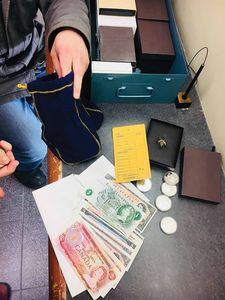
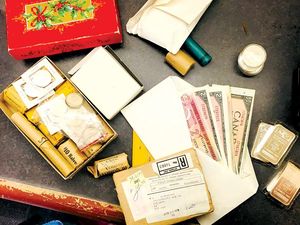
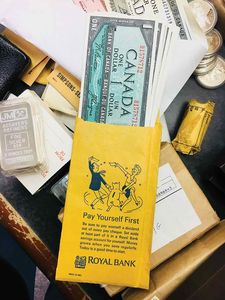
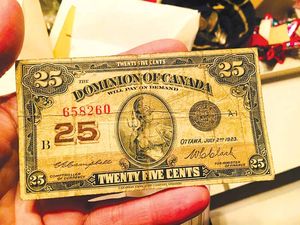






Postmedia is committed to maintaining a lively but civil forum for discussion. Please keep comments relevant and respectful. Comments may take up to an hour to appear on the site. You will receive an email if there is a reply to your comment, an update to a thread you follow or if a user you follow comments. Visit our Community Guidelines for more information.